March/April 2011
Crossing the Pass of the She Camel
We Arrive in Morocco
The Pass of the She-Camel is, in Arabic, Tizi n’Talrhmeht. It is in Morocco, as are we. As a pass, it’s not that special; but as far as names go, we dare you to go us one better!
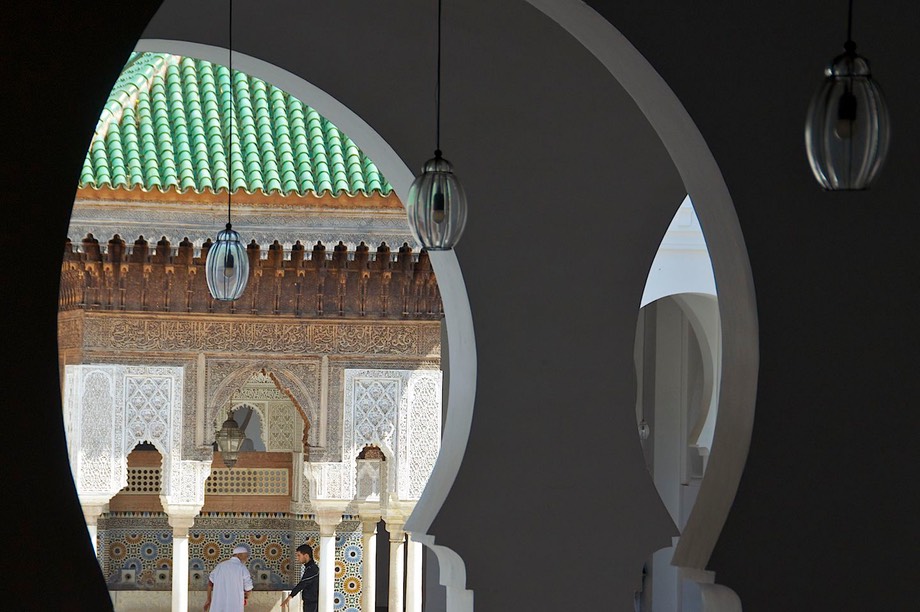
On the road to Morocco, we spent our last night in Spain, or so we thought at the time, in a natural reserve near a wetlands. It was very windy (which should have been a clue as to what was ahead), but the canopy of trees kept the worst out, and we spent a peaceful night. We were a bit up the west side of the Spanish peninsula; the road drops south to Tarifa (the southernmost point in Europe, believe it or not) before rounding the point and going a little up the eastern shore to Gilbraltar. Do I have you oriented now? Tarifa, by the way, has an extremely high suicide rate; they say it’s because of the constant winds – we can vouch for that! They also say that, on a clear day, from Tarifa you can see across to northern Africa. Today? Only murk.
We were heading for the ferry out of Algeciras, tucked up tight against Gib (as the locals say). We scrambled to find a good place to do some last minute shopping. We did have the option of crossing into Gibraltar, which belongs to the British and was reputed to have some interesting things on offer (at some not so interesting prices), but it would be a last resort. Do-able both on foot and by truck, but as a hassle either way, it wasn’t our first choice.
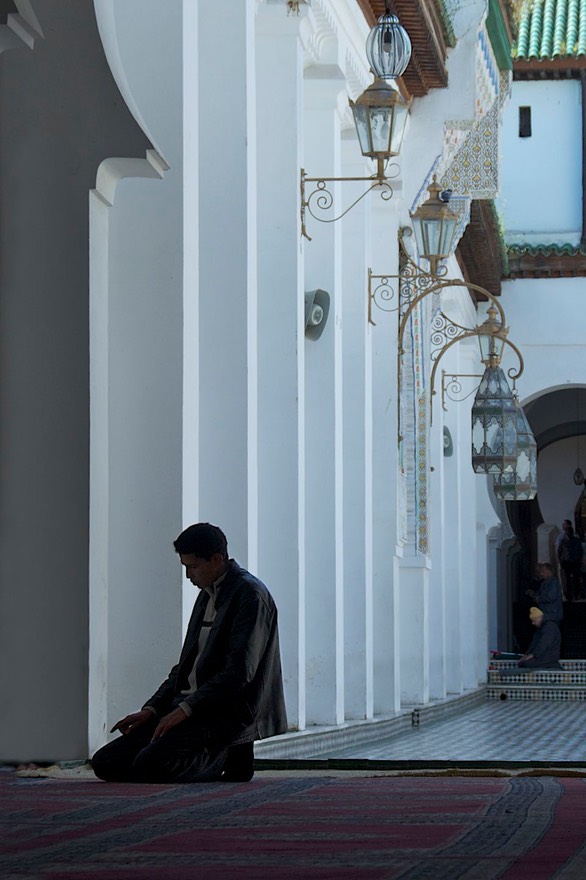
The wind was getting worse, and it was raining. But we found a couple of good stores and raided them for stuff we suspected would be in short supply in Morocco. The refrigerator took it all in, and we went off in search of ferry tickets. We’d been filled with good advice on where to go, who to see, etc. Picking and choosing amongst the bits of help offered, we ended up finding “Carlos, who is across the street from the Carrefour and has really cheap deals.” Well, who knows. But he took good care of us, and stocked us up with a Bon Voyage bottle of wine and a sponge cake (cake very good; wine waiting for our anniversary later in April). But “probably no ferries today, señor, although your tickets are good for whenever the next one leaves the dock. Right now the weather is terrible. But go to the dock and see what happens.” So go we did.
And we saw. And we waited. And found that no, señor, not today. But you may of course stay right here in line for tonight; tomorrow will probably be better.
In fact, we had a quiet night in a protected, covered area, along with two other motorhomes, while the storm raged around us. And tomorrow was better. Eventually someone told us that we would be leaving about 11:00. Of course, about 10:00 there was mass confusion, everyone fought for space in line to get on the ferry, and then we sat for a couple of hours before leaving. The seas were still rough (no one was allowed out of the main cabin, no, NOT FOR ANY REASON) and the crossing took about an hour longer than scheduled, but finally we arrived in Ceuta, still in Spain.
Still in Spain? Confused? No surprise. We could have taken a ferry straight to the port at Tangier, which is actually in Morocco. But advice from many was that Ceuta, a Spanish port on the Mediterranean coast of northern Africa, was a better choice. More straightforward and less confusing, cleaner, and a cheaper crossing. From there it’s an easy border crossing into Morocco, just a few steps away.
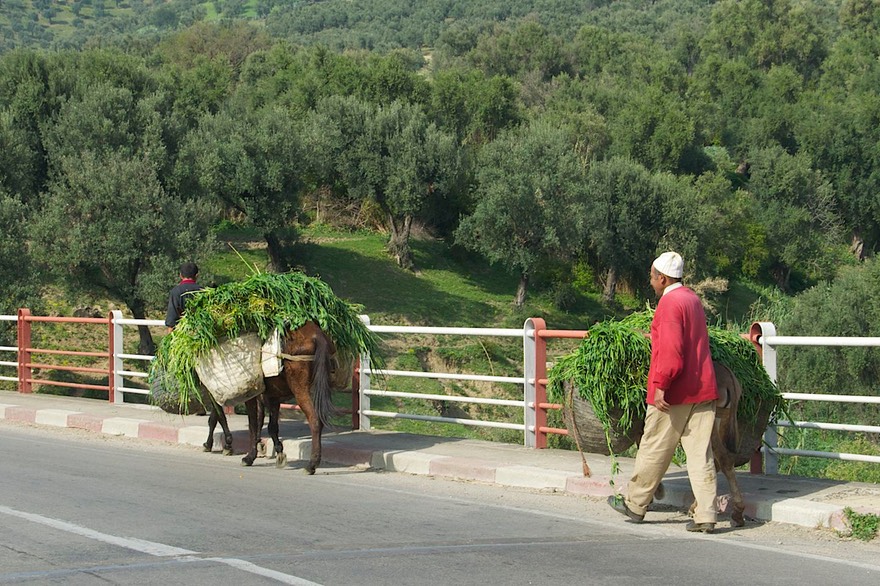
And, as advertised, in about half an hour we were across into Morocco. And into another world. Uniformly, our first impression was that we’d taken a wrong turn and were back in Latin America. Morocco is definitely a less developed nation. Lots of new construction in the midst of junky vacant lots, trash, and mangy dogs. Rocks and pieces of wood being used to control where traffic goes, and other signs of making do with materials at hand; bicycles/motorbikes as the means of transportation, donkeys as the beast of burden, etc. As the weeks have gone past, we’ve had to add the other Moroccan trademark: too many panhandlers and pushy people giving you the hard sell right and left.
A lot of people here are working very hard for a subsistence-level existence. In some cases, the men have left for work in the cities and the women are coping at home. And (perhaps an overgeneralization) far too often it seems that the women are the beasts of burden and doing the work, the men are either sitting in the cafes drinking tea or trying to sell you something, and the children are off begging or tending the sheep or goats.
But please do not take this to mean that our experience has been unpleasant. We’d been told ahead of time that everything I’m telling you is absolutely true – what needs to be added is that this is a very interesting country with very friendly and helpful people who are happy to see us. And we are having great adventures.
Looking at the country and its opportunities, and given that spring was upon us, we’d decided to follow some good advice and head directly south. We wanted to get down into the desert, the edge of the Sahara, and we knew it was going to get pretty hot pretty soon. So we pretty much set our compass due south.
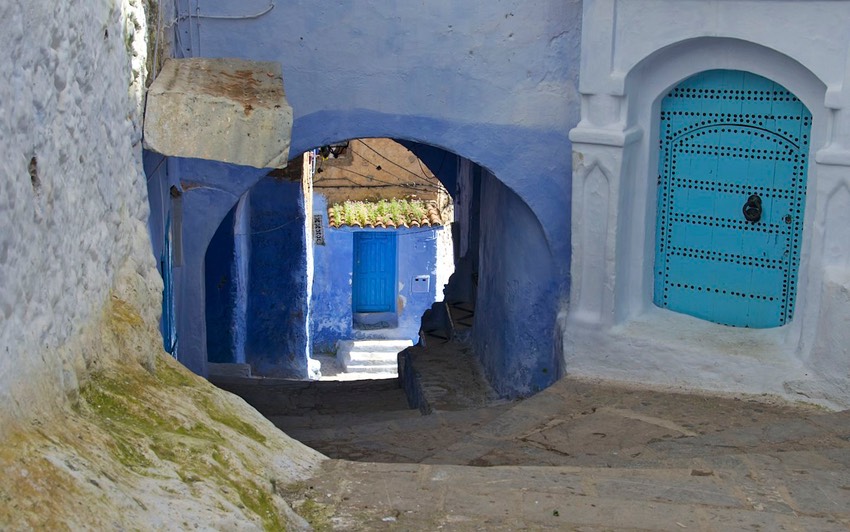
We spent our first night along the beach promenade in Martil, right on the Mediterranean Sea. The wind was still up and we had a bit of a messy night, between actual rain and sand mixed with salt spray off the water. But we slept well. In the morning we noticed we were decidedly listing a few degrees off center – the culprit was a bolt in one of the tires, making it dead flat. Welcome to the real world!
After using our handy dandy air compressor (don’t leave home without one) to re-inflate the offender, we headed off in search of a good tire repair shop. We ended up in Tetouan, a few miles south and the original capital of Morocco. Wandering around, we were taken in hand (despite our best intentions to go it alone) by a nice fellow on a motorbike who took us to his “cousin’s shop” which actually turned out to be a very good, very modern, very large fuel station. They took excellent care of us, and then Mohammed showed us around the ancient medina for a bit, as well as walking us around the shops where students were learning the ancient art of hand-inlaid wood. We enjoyed his company, learned quite a lot, and it was a good introduction to wandering the souks of this country. Now, of course Mohammed was a paid guide and we eventually paid him for the half day that he spent with us; also, he did as guides always do and took us into a shop where we were expected to buy a rug. Nonetheless, the whole experience ended up being pleasant and positive despite its dark beginnings and we left town with good feelings and a somewhat better understanding of this new country.
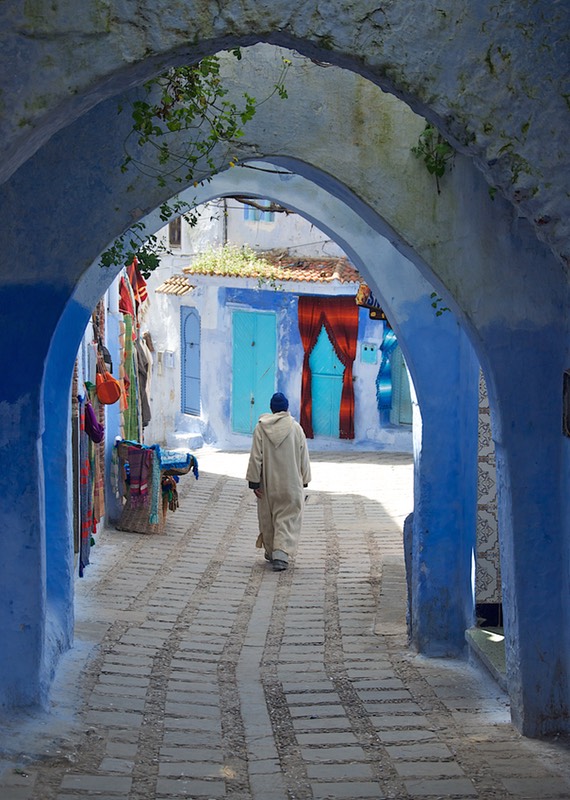
Leaving town, we passed sheep on the sidewalks eating the grass in the vacant lots, horse-drawn carts, bike-drawn trucks, trucks piled with people, roosters dodging traffic, tethered critters feeding beside the road – all the usual. We felt at home. and, most marvelous, oranges were everywhere. We are having fresh juice in the mornings and fresh fruit at night for dessert; heavenly!
Our first destination was the “blue town” – Chefchaouen. To date this has been our favorite place in Morocco. The architecture is a bit different from other towns in that the buildings have peaked, orange-tiled roofs rather than the normal Arabic flat roofs; the buildings, going down the steep hillside, are white-washed but with a blue tint to the white and deeper blues mixed in with softened edges like in a watercolor painting, giving an ethereal appearance that is quite enchanting. The play of color in the strong sun is marvelous. We stayed in a campground high up on the hill and took the steep path down into town, then found a taxi to take us home again. We had lunch in a small nook of a spot, tajine and fresh bread, that delighted us. We really enjoyed ourselves here, and hope for a return visit as we work our way back north and out of the country.
Moving south we were surprised at how much cactus we were starting to see, mostly prickly pear and agave, all amongst the lush green countryside. We skirted the edge of the Rif Mountains. Having been warned by several other travelers not to venture into this area, we kept on moving, suffering no adversity. If the Rif Mountains are unknown to you, this is the center of hashish production in Morocco, reportedly a somewhat wild and dangerous region.
Staying on the beaten path we soon dropped down into a large fertile plain filled with grain under cultivation, interspersed with the poppies and other wildflowers we have been seeing consistently ever since.
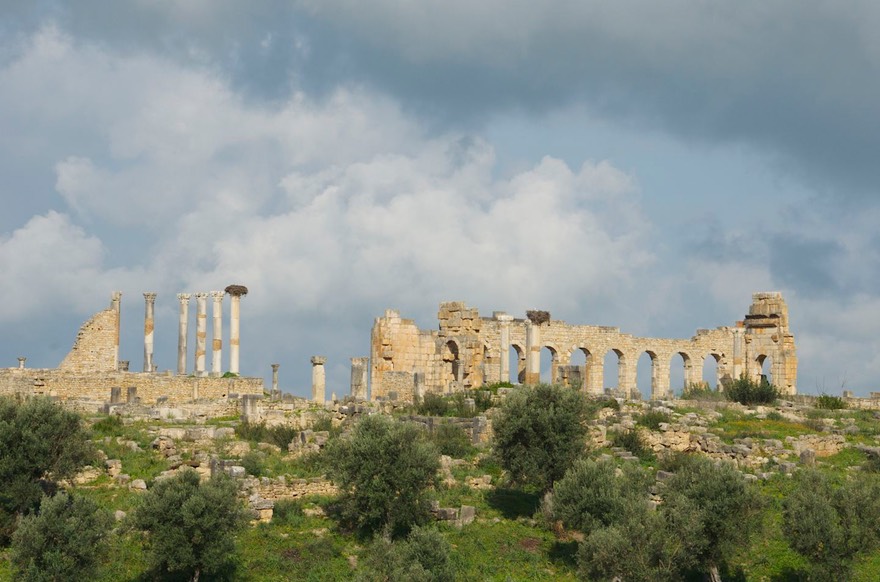
We wanted to see the Roman ruins at Volubilis, near Meknès. We ended up staying the night at a campground nearby, then visiting the site early in the day, when the light was very good on the stones and columns. This is an extensive site, the most important in Morocco. Volubilis was the most remote outpost of the Empire, and very important. It has been well preserved and there are lots of mosaics to be enjoyed. We had a lovely morning, and having arrived quite early, were able to enjoy the site almost by ourselves.
Well, so on to Fes. Ah, Fes (also Fez); filled with good and hard adventures. The goods? We tackled the medina on our own and survived the experience. Kathy tried and enjoyed couscous. (Rick declared his tajine not as good as at the little hole in the wall spot in Chefchaouen despite being five times as expensive. But he’s still game to try). We had decided to purchase a dongle for Moroccan internet, and we accomplished that. But Fes gave us some problems, among which was a pick-pocketing experience on the bus between the campground and the city (not overly expensive, but aggravating, and disappointing).
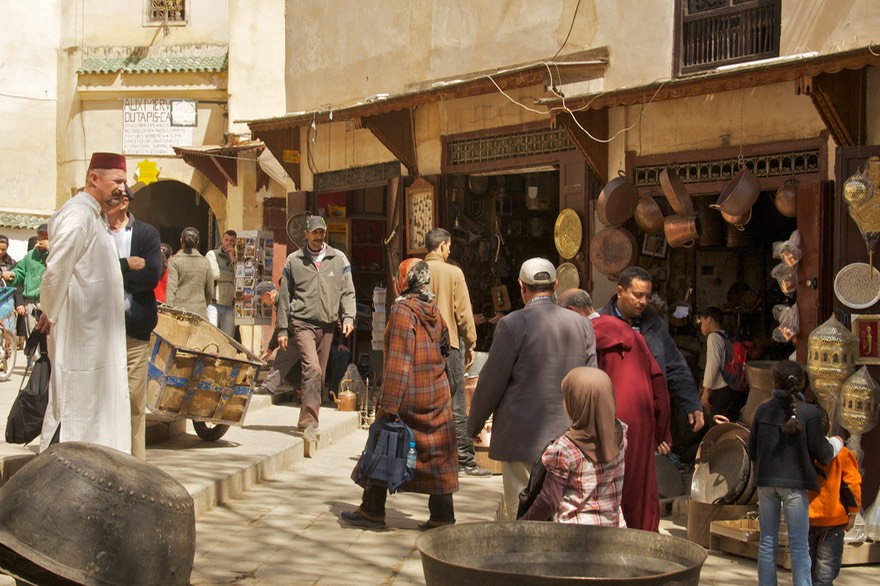
We think we’d like to return to Fes, and if we do we will hire a guide. Rick is terrific with finding his way around, and was pretty darn successful in the medina, but by the third time we passed the same fellow trying to get us to step into his little shop just to see one little thing -- just to look, sir, not to buy -- it had become embarrassing and we declared ourselves befuddled; we finally gave up, never having found a couple of the spots we were quite interested in locating. But hey, we got some great pictures anyway. Oh, and a lesson learned the hard way: do not, under any circumstances, think you will be successful in buying (very) ripe strawberries in the medina, and then get them back to camp in one piece when you are going to spend 2 hours more wandering and taking the bus home. Strawberry jam, mostly. But still delicious.
All the warnings about Morocco had been insufficient in preparing us for the phenomenon of the multitudes of French motorhomers. They are absolutely everywhere! Morocco was, of course, in recent history a French possession; the country achieved independence in 1956. The French think it’s still theirs, at least the retired ones do. Individually we like the French, and count several good friends among the multitudes. But in groups, wow! There must be 37 times as many French in Morocco at any one given moment as the members of any other tribe. The campgrounds are full of them and we non-French inevitably feel somewhat on the outside. After awhile it becomes time to try and find a place for just ourselves.
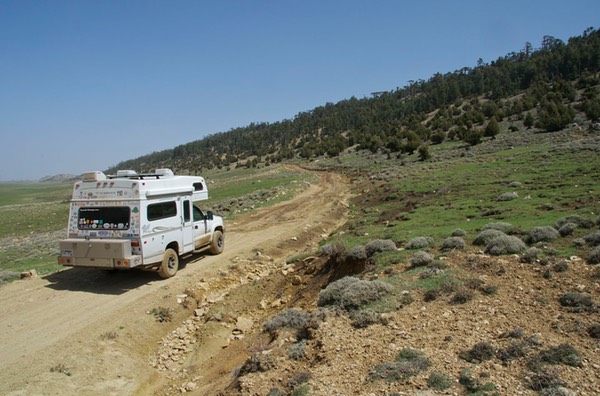
Leaving Fes, we kept moving south. Between us and the desert were mountains, the Middle Atlas. Lovely, they, and we had found solitude. We wandered happily along dirt roads (pistes), never getting stuck but realizing we were pretty high up (above 7,000 feet), there was still snow on the ground, and it was goopy to say the least. Trusty Tiger came through with ease, and we enjoyed ourselves a lot. We came across a lake, the Dayat Aaoua near Imouzzér du Kandar, and parked there for a couple of days, in total serenity. We walked and read and had a great time. This lake is a place where locals come to walk and just enjoy their surroundings; happily they were willing to share the area with us.
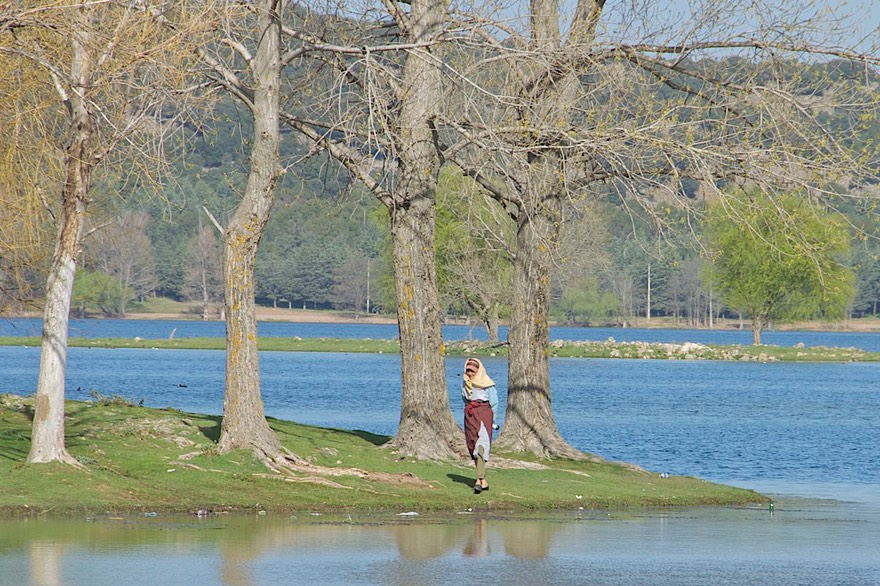
This area is forested with cedars and they had been a welcome sight; we hated to see them disappear after we dropped down towards Midelt. We might have given this crossroads town a miss, except for The Man from Marfa. A great story. In Fes, while at the campground, a fellow came up to us saying “Are you really from South Dakota?” – in a Texas accent. Turns out he’s a doctor working in Midelt trying to make life better for the Berbers of the area. And he’s from Marfa, Texas (you know, the place with the weird lights at night). He was on his way to Casablanca to pick up his family, who’d been back in the States for a bit. Anyway, we chatted, and he suggested that when we came through we give him a call and we’d have tea. So we did. It was a kick. Met the family, had some lovely mountain tea and a bite to eat, and left for the Tizi n’Talrhmeht pass (see above). Well, she-camels aside, not much was happening going over this low pass through the High Atlas Mountains (only 6220 feet), but it was fun nevertheless.
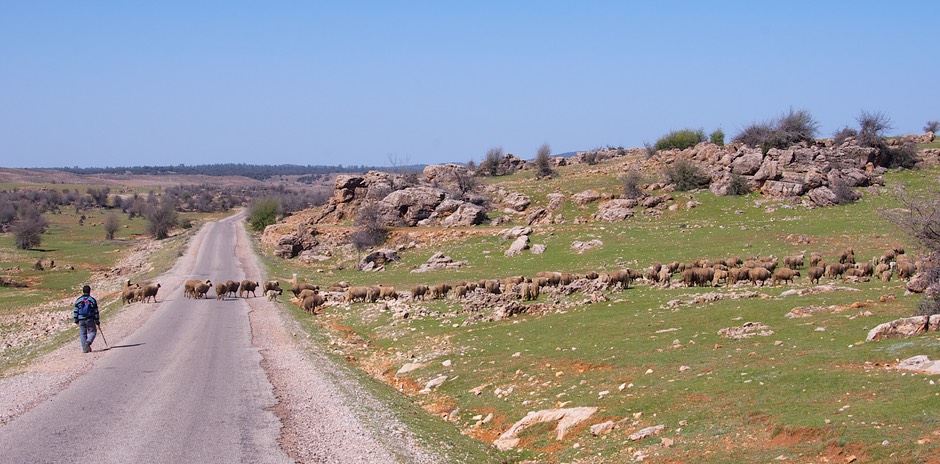
The High Atlas Mountains are pretty stark, but quite dramatic. We followed the Ziz River, finally dropping down and into Er-Rachidia, the start of the desert and the first of the palmeries (we would call them oases in California – but fewer Hollywood types hanging around and playing golf). We really like the palmeries, and over the last couple of weeks have stayed in several. In general, they are cool and breezy, shady, have running water flowing in irrigation channels throughout, donkeys braying their opinion on every little thing, birds singing, and if you’re lucky a guy will show up about 8:00 in the morning with fresh bread for sale.
So, we were in the desert. And now the interface between romance and reality came on board. The English Patient is one of our favorite movies, and to us it represents both the good and the harsh about the desert, but always the romance is foremost. Well, sorry guys. Reality’s less interesting to us. We’ve taken in a lot over the years, and enjoyed it all. But wind and a nasty sandstorm and too many 4x4s and motorhomes and beggars and dirty little towns…but I’m whinging. Anyway, we visited Merzouga and the magnificent Erg Chebbi dunes. The dunes themselves are as beautiful as we’d been told; unfortunately they are located in the middle of a plain old ugly desert that shares none of their charms. Then we crossed more desert heading over to Zagora and the lovely Drâa valley.
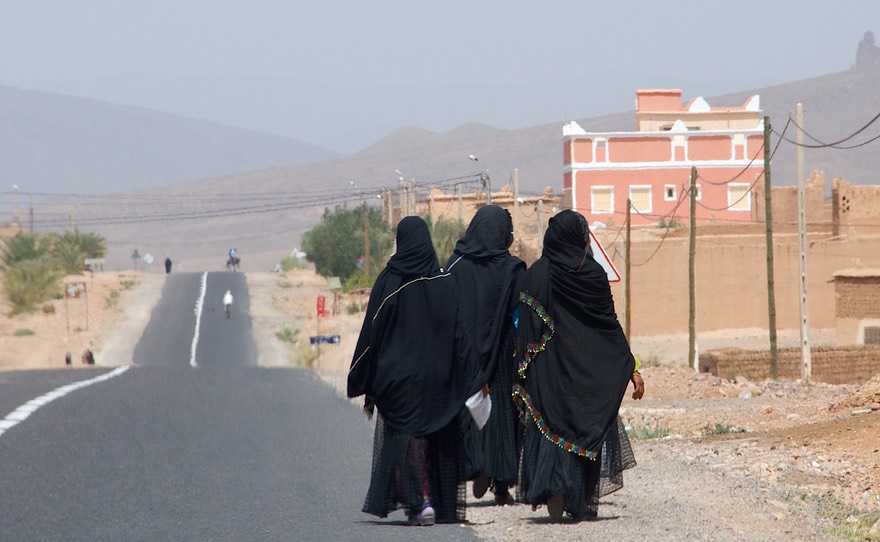
In Zagora our Chevrolet truck was greatly admired by the locals. The power under the hood (“good camels”) and its sturdiness were well respected. Rick was offered 4 camels in trade for the truck, and 3,000 for Kathy; he considered neither seriously, but claimed that he thought the value relationship right on; what a guy. We made one last stop before leaving Zagora; we located and photographed a famous sign that lets the traveler know that it’s 52 days by camel from Zagora to Timbuktu! We’ll have to take their word for it.
And then we went on. Those of you who have had such wonderful experiences in these areas will be disappointed for us. But we all know that everyone’s trip must be their own experience. Never having been desert lovers, and faced with steadily increasing temperatures, we decided we’d rather see some of the Atlantic coastline and then go back up into the mountains, our preferred habitat. But two fun things: first, we’d stopped for fruit in Rissani, north of Merzouga, and were chatting with an older fellow there. When he found out we were Americans he said he was in the States every winter; he has a fossil market store in Rissani, and he takes his wares to Quartzite every year for the big fossil show. He was delightful, not trying to sell us anything, and we enjoyed a nice talk with him.
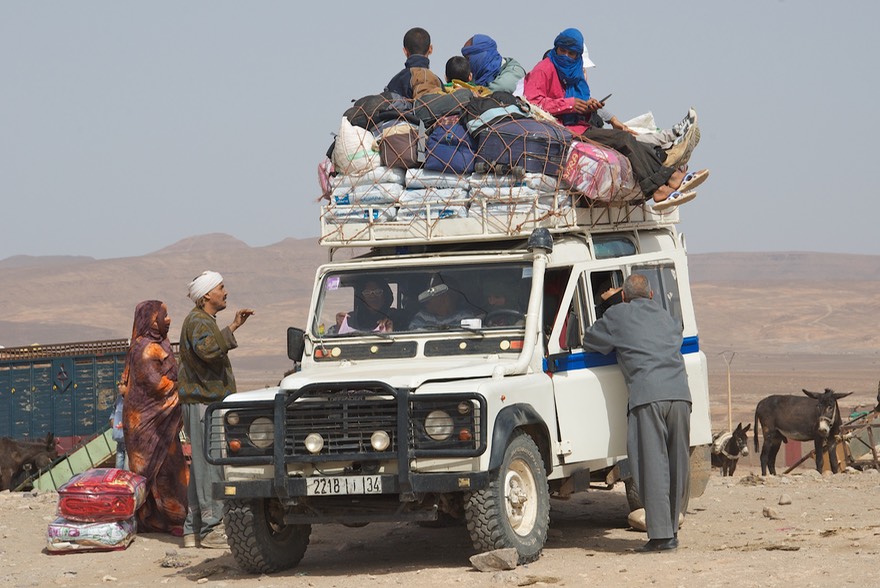
Second fun thing: we saw plenty of camels. Some brought out for the tourists, of course, but also groups of them used as pack animals, and then later on a large herd grazing along the side of the road along the coast north of Sidi Ifni, next to an abandoned housing project. They are quite magnificent on their home turf. Dromedary camels – one hump.
I’ve also forgotten to mention the ksars (kasbahs) we’ve been seeing all throughout southern Morocco. These are old mud buildings (mostly ruins) that were used for storage – grains, other food stuffs, weapons, everything of value – for protection from attack. They are dramatic and picturesque, and in every case they reflect the colors of the earth in the area, making each one quite distinctive. They were a pleasure.
Leaving Zagora, we worked our way up to Agdz and then turned left through the scrub, with the stark Anti Atlas Mountains looming over our right shoulder. We started out crossing a high desert plateau, commenting at one time that this was one of the most desolate areas we’d ever seen, but soon entered the Souss River valley, much softer and greener and quite delightful. This is the area where all the saffron in Morocco is grown. That sounds quite splendid, but in actuality Morocco isn’t a big player on the world market, although the quality of Morocco’s saffron is supposed to be the best to be had. In any case, the valley was a revelation and we were quite captivated. We spent the night looking down on the town of Taliouine, in the heart of the area, set in a dramatic bowl-shaped small valley.
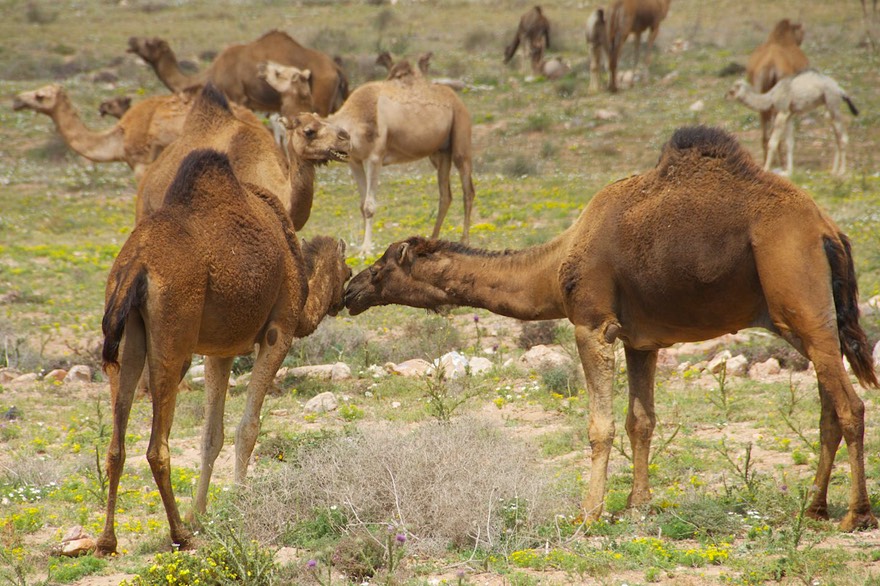
The road followed a long valley carved by the Souss with, in addition to the saffron plants, grain crops and then citrus orchards. Donkeys were tethered out to grass; there were wildflowers everywhere; it was a lovely spring day. The aroma of the citrus blossoms permeated the air. We started seeing overloaded small trucks coming towards us. Apparently Ouled-Teima, the market town ahead of us, had animals for sale, because there were more and more cows, and sheep and their lambs, and hens, too, showing up in the truck bed or on racks on top; sometimes people were up there too. It was quite a parade.
We were dropping in altitude, down toward the coast. We decided to take a run into Agidir for some shopping. Well, maybe a mistake. When we arrived it was 104 degrees. We shopped (cool inside, thank you!) and then split for a run down the coast. We’d decided to see some coastline, and visit Sidi Ifni, supposed to be an interesting spot.
Well, it didn’t get cooler that night. Just before dark we finally stopped in Mirleft, where it was still 85 degrees at 10:30 that night. We never had dinner, but sat outside munching nuts and using all the ice we had trying to keep our drinks cool. Forget cold. The next day we went a little further south and the temperature dropped down to a cool 67 degrees in Sidi Ifni; sure wish we’d kept going the night before!
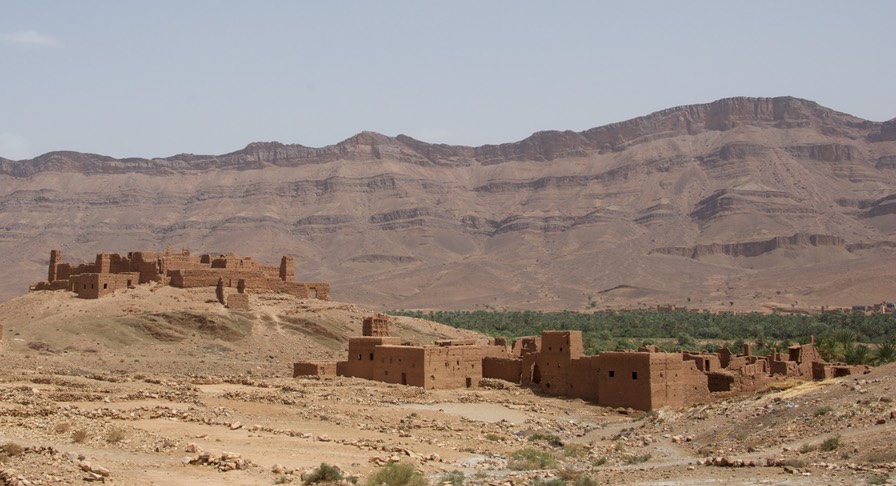
Folks like Sidi Ifni; it’s known as the Art Deco town because a whole bunch of buildings were constructed during that time frame and they are sort of interesting looking. But they are faded now, and need attention. We might have spent a little more time poking around, but the area around the plaza, where the “good stuff” was, was enjoying a sit-in by some local students. Police were everywhere, standing around frowning but not looking intimidating; the kids were mostly just sitting on the edge of the street. But we felt we weren’t going to add anything to the party, and might aggravate the situation, so we kept movin’ on.
Sidi Ifni has an abandoned airstrip at the edge of “downtown”; seemed somewhat bizarre, but we parked there for a nice cool lunch and then hit the road. We retraced our steps back up the coast as far as the road would take us. It stayed lovely and cool. Morocco appears to be trying to develop large sections of the coastline, and there are half-finished projects everywhere. Sad. But coming around a corner we happened on the aforementioned grazing camels. What a treat! They were calm, we were shutter-happy, and the camelherd even left us alone, presumably sensing we were not in the market. We see and enjoy herds of goats and sheep just about everywhere in Morocco; and we are of course known to be easily amused, so it seems we never get tired of watching the grazing critters. Nonetheless, seeing camels in the same sort of setting and doing the same things is indeed somewhat more exotic.
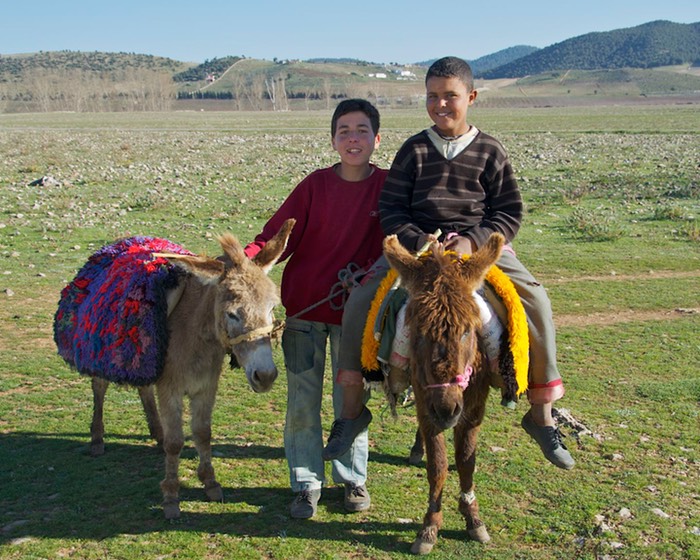
We turned east at Tiznit and have now returned to the mountains, where we have settled for a few days amid the stunning landscape around Tafraoute. The trip up here, over a very narrow, windy mountain road, had its own adventure. Just as we came to a tight, blind corner, there was an accident right in front of us. No one was hurt, although the cars were badly damaged; we were waved on through, but it served as an unneeded reminder that the roads we love the best do leave us vulnerable at times.
We are on the edge of town, looking out at enormous rocks and palms, and we have a mixed herd of goats and sheep that passes us by several times a day as it grazes on the grass and low bushes in the area. It’s quite warm in the middle of the day but cools down beautifully at night. We are very happy here and there is much to see and do in the area.
We have many adventures and lots of great scenery awaiting us. But we have so many pictures and stories to share with you already that we thought you might enjoy hearing from us. Life is good.
Rick and Kathy and La Tortuga (“I’ll trade you four camels for this truck”)
Click to see more photos from Morocco